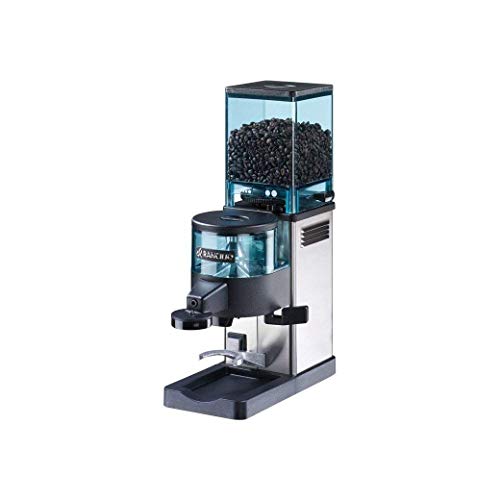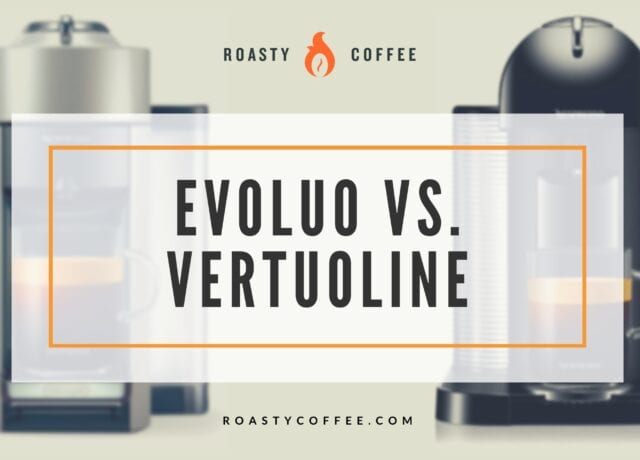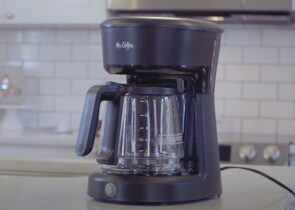Are you looking for a high-quality commercial coffee grinder for your coffee business? A durable, reliable, well-made coffee grinder is going to be one of the most important purchases and will determine the overall quality of your coffee. Usually, a commercial coffee grinder will be larger, more powerful, and are equipped with more features than a regular basic home coffee grinder.
However, looking for one can be somewhat overwhelming. That’s why we did most of the grunt work for you! Read on to find the best commercial coffee/espresso grinder for your business.
Why Get A Coffee Grinder?
Well, if you’re looking for a commercial coffee grinder in the first place for your business, then you should already know the importance of commercial coffee grinders. The most obvious reason as to why they’re necessary for brewing coffee because you can’t just brew coffee without breaking down the whole coffee beans into smaller grounds. The main purpose of the grinder is to break down the beans into grounds that range from small to large in order to make a wide variety of coffee drinks.
If the coffee beans are broken down into grounds, it’s more difficult for water to filter through them, since the grounds are more physically compact than whole beans. As the water struggles to filter between the grounds, the flavor of the coffee is extracted. This is why grinders are crucial to making coffee.
Furthermore, grinding coffee right before brewing is the best way to make sure your coffee is as fresh and flavorful as possible. Any professional coffee connoisseur will vouch that freshly ground coffee is better over already ground coffee, which is why choosing the best commercial grade machine to meet your needs is important to how well it will fit your business needs.
Different Kinds of Coffee Grinders
Now, there are many different kinds of coffee grinders for you to choose from when on the market for a big scale commercial coffee grinder. Before you begin shopping, here are some of the important kinds of coffee grinders you should know about before officially choosing your designated grinder.
Burr Grinders
Across the board, burr grinders have been the preferred grinders of choice for those who are commercially selling coffee. This is because they allow flexibility for grind size, not just with the range of sizes, but also with grind uniformity. This feature makes them a favorite of many professional baristas, as well as commercial coffee shops.
Burr grinders get their name because they consist of two serrated blades that oscillate around one another (hence the name “burr”). These grinders don’t actually cut or slice the coffee beans, but they instead actually grind them together, breaking them down. Furthermore, many baristas tend to prefer burr grinders because they aid in the extraction of oils from within the beans, enhancing the flavor of the coffee.
The two most popular types of burr grinders are conical and flat. There is much debate in the coffee community as to which style is better for both domestic and commercial coffee. Our primary analysis on the subject is that though there are significant differences in both techniques, they both perform well and also create beautifully ground coffee that will make consistently delicious espresso.
Conical Burr Grinders
The most popular burr grinders for many coffee shops are conical burr grinders. The first noticeable characteristic of conical burr grinders is the design of the burrs themselves. Due to the cone-like shape, a conical burr grinder will naturally force the beans downwards in between the blades. The outer serrated burr sits around the venter burr, which is a small erect cone covered in sharp blades, breaking down the coffee beans into smaller pieces.
Many baristas favor the conical burr because it creates something called bimodal distribution. If you were to grind coffee with a conical burr grinder and then observe it underneath a microscope, you’d find that the grounds look uniform in size to the naked eye, but are actually two different sizes. With one grain slightly smaller and one slightly larger, the balance of the two sized grinds both encourages and restricts water flow. Though it may sound a little counterproductive, this method is a favorite of many experienced baristas because it actually makes for a smooth, strong shot of espresso.
Flat Burr Grinders
The flat burr grinders are a much different story. As far as the positioning of the burrs is concerned, flat burrs have two horizontal blades, one that faces upwards while the other faces downwards. Coffee beans are fed in between the burrs and are ground down before dropping between them for a second time. Through this method, the coffee grounds make two 90-degree turns in between the blades to ensure that they’re broken down enough in order to begin brewing.
Unlike conical burrs, the flat burrs are allowed to physically interact with one another. This results in a unimodal distribution, meaning that if you were to hold the coffee grounds under a microscope, all of the grounds would be identical in size. Though this may work for other coarser brewing methods such as pour-overs, drip coffee, andFrench-presses, it doesn’t do so well for espresso brewing, especially large-scale espresso brewing at a cafe or a coffee shop.
The only minor cons that some baristas complain of when it comes to flat burr grinders are that they can produce more heat and noise while grinding in comparison to its conical cousin. Furthermore, it’s easier for coffee grounds to get stuck in between them. Unfortunately, if this happens often you’ll probably end up wasting more grounds than you’ll actually be using with your flat grinder.
Doser Grinders
Whether a grinder is a doser or a doserless grinder doesn’t really have anything to do with the method of coffee grinding itself, mainly just the way that ground coffee is dispensed after grinding. Usually, doser grinders have a chamber that the coffee grounds are deposited into, as well as a lever to pull to release the grounds in set increments into a portafilter.
Most doser grinders are electronic, and will accurately divide up the coffee through accurate electronic programming. However, though they are extremely helpful to the commercial coffee industry because it quickly doses out small amounts of coffee to make for efficient espresso brewing. Furthermore, since it grinds larger amounts of coffee at once, you’ll have coffee that’s already been ground and is ready to go during a busy day at a highly trafficked coffee shop.
Doserless Grinders
Instead of depositing them into a reservoir, doserless grinders deliver the coffee grounds straight into the portafilter basket through a chute, making it the quickest method of espresso brewing. Most of them are manufactured with a button on the side of the machine that will control the starting/stopping of dispensing grounds.
As far as ease of operation is concerned, doserless grinders normally require experienced baristas, as they’ll have to eyeball how much coffee is released into the portafilter. Many coffee shops favor doserless grinders because when operated by experienced baristas, they can be very flexible, effective, and can produce some delicious espresso as quickly as possible.
A few more positive traits of these grinders are that they allow for control over the dispensing of grounds, minimizing coffee waste, as well as making sure that coffee is as fresh as possible since its ground according to the barista’s own judgment. The only downside to these grinders is that they require experienced baristas to operate them, as well as the fact that they can produce a bit of a mess since they lack a bin for the dispensing of grounds.
Stepped Grinders
One of the least common coffee grinders used in the commercial coffee setting, stepped grinders are ideal for some baristas because they allow for easy adjustability of grind size. If you’re in a rush to switch grind size and don’t have time to dial in your machine, a stepped grinder can allow easy maneuvering. Often, baristas tend to favor stepped grinders because they are flexible and user-friendly, and they can also “lock-in” a certain grind size. This means that the grind size won’t alter or change after you’ve used your machine several times. This prevents you from having to dial in your grinder more often than you’d prefer.
However, this can be a double-edged sword. Since changing between grind settings can be easily and quickly done, there can be a lack of quality for some grinding sizes. For example, instead of offering a variety of different grind sizes, there may be larger gaps in between a smaller number of grinding settings, creating differences between grind sizes that are only one step above or below each other.
Stepless Grinders
If dialing in your grinder to get the precise grind possible is your main concern, then a stepless grinder may be exactly what you’re wanting. They are more adaptable when it comes to adjustments and the sharp focusing on grind sizes, and they also even have stepped grinders with preset notches to help determine grinding sizes.
Stepless grinders can be a favorite of many baristas because they also include the ability to find the most precise settings as possible for whatever kind of coffee that you’re grinding. As a result, this helps create the most ideal level of extraction possible, and it also allows you to experiment more with espresso brewing. Since they allow baristas to fine-tune their espresso, they can ensure that each shot pulled is consistent in flavor, texture, body, etc. Long story short: if you care about getting the most accurate grind possible for your coffee, then a stepless grinder is worth your reviewing.
Qualities To Look For In A Commercial Grinder
As you begin shopping around for the best grinder to complement your coffee business, it’s important to be aware of what qualities to search for when deciding between which grinder is best for you. Here are just a few that we believe it’s important to consider when narrowing down what the best commercial coffee grinder is for your business.
What Is Your Business?
When considering which commercial coffee bean grinder is best for you, the first thing you should consider is what type of business you have. This will help you determine exactly what level of commercial grinder you’ll need. Ultimately, if you aren’t planning on selling coffee for the majority of your business’s income, then you won’t need the fanciest commercial level grinder. If you’re looking for a coffee grinder simply for home brewing or just for the work office, then you can easily buy a simple conical burr grinder for your kitchen.
However, if you’re running a business such as a restaurant, cafe, or coffee shop, then having a higher quality grinder will create high-quality your coffee–especially espresso.
What Volume Will You Be Producing Coffee?
Most coffee shops that need to pull espresso shots at a faster pace will probably need a doser grinder to keep pace while measuring out your grounds. Likewise, more boutique, slower-paced coffee shops will probably want a doserless grinder to make sure that their beans are ground as closer to brewing as possible, ensuring the highest quality flavor and freshness. Businesses like restaurants will enjoy stepped grinders due to their ease and efficiency, and more skilled, independent baristas will enjoy the stepless grinders in order to perfect their craft.
Personal Grinding Preference
Another factor that’s important to consider when purchasing a commercial coffee grinder is what grinding style you’d prefer. Between conical burrs and flat burrs, there is a different result between the coffee grounds, and these differences will determine which method is best for your business. This all really comes down to personal preference, since every trained barista is bound to have a bias on what they may prefer.
Best Commercial Coffee Grinders
Nuova Simonelli Mythos Commercial Espresso Grinder
If you’re looking for an espresso grinder that will grind quickly, efficiently, and effectively without spoiling the quality of the coffee from the usage of heat and friction, let us introduce you to the Nuova! Constructed with stainless steel 75mm flat burs, it has the ability to grind through 39 pounds of coffee in an hour. It’s a powerful machine, and it’ll be able to keep up with how often you’ll be grinding, as well as how fast. The efficiency of this commercial espresso grinder will also pair well with all commercial grade espresso machines.
Not to mention it’s also incredibly efficient. Consisting of micrometric adjustments, the Nuova also ensures that you’re grinding is as precise as possible. Furthermore, with the help of electronic programming, it also features three programmable timed dosage settings, as well as a delayed time setting so that you can make adjustments or manually add coffee to the grinder if needed. A stepless grinder, the Nuova is also effective for dialing in your grind as precisely as possible.
Baratza Forte BG Brew Grinder
Looking for flexibility in drink variety? Another flat burr grinder, the Baratza Forte was actually named Best Commercial Product at SCAA 2013 and has been a huge favorite among many baristas due to its ability to grind coarser coffee. It’s a weight-based grinder, meaning that you can set your grinder to produce a set amount of ounces of coffee, and it will grind that amount of coffee before shutting off.
It’s smaller in size, but don’t let that fool you. With 260 grind settings, this machine packs quite a punch when it comes to grinding power and flexibility, and is partially made of stainless steel. It has 54mm flat burrs and is specifically designed for slow bar brewing, meaning that it’s not the best for grinding espresso in large quantities in short amounts of time.
Though it’s inefficient for a more hectic coffee shop setting, it’s perfect for highlighting more exquisite coffee profiles. Furthermore, the Baratza has also been integrated with a new bean hopper, one that allows easy removal, and prevents beans from falling down into the grinder chute, allowing baristas to switch coffee beans with ease.
Eureka Zenith 65 E Hi-Speed Espresso Grinder
If perfect espresso is your aim, then you should up your coffee game with the Eureka Zenith 65 E Hi-Speed Espresso Grinder. This electronic grinder has quite a large amount of credentials, and it’s 65mm flat steel burrs have received much recognition for their ability to produce some of the finest, most uniform espresso grounds possible.
It has two programmable dosing options, as well as a micrometrical adjustment wheel. Since it’s a stepless grinder, it’s easy to dial in the grinder. Since the grind adjustments are changed using the bottom burr, the Zenith doesn’t easily lose its calibration.
Though the main perk to this is that it saves valuable time and coffee, one small downside to the Zenith is that it is often too large to fit underneath a kitchen cabinet or shelf. So, the most ideal place is on a countertop in a populated coffee shop. Not only will it look nice, but it will deliver delicious espresso to customers in only a matter of seconds.
Rancilio MD 40 Commercial Burr Espresso Grinder
This semi-automatic commercial grinder is a favorite of many baristas for a multitude of reasons. It’s constructed out of die-cut aluminum that’s been covered in a layer of steel. In addition, the Rancilio MD 40’s bean hopper is blue-tinted and is designed to hold up to a little over a pound of coffee beans. The tinted hopper is specially constructed to block harmful UV rays that can spoil coffee beans. It’s a doser grinder and is designed to easily dose out the correct amount of grounds into a portafilter for efficient espresso brewing.
With burrs that are 55mm in length, the Rancilio has a low amount of rotations per minute when grinding, keeping the heat and friction to a minimum and thus preserving the quality of the coffee. It’s made of tempered steel, ensuring that the blades are strong enough and durable enough to last for a long while.
Mazzer Robur Automatic Espresso Grinder
With impressive 71mm conical burrs, the Mazzer Robur is build to last for the long-term in hectic, highly trafficked coffee environments. One of the larger models that the company manufactures, it can hold about 4 pounds of coffee beans, making it great for grinding large amounts of coffee during a busy rush.
In addition to its impressive size, the Robur also does a fantastic job of keeping heat and friction levels low while grinding. So even if it’s been running all day, you can rest assured knowing that your coffee is still going to be as fresh and high-quality as possible. With a stepless micrometrical grinding adjustment, this machine can produce precise, consistent espresso every time.
No products found.
Baratza Sette 270 Wi-Grind Conical Burr Grinder
Awarded Best New Product by the Specialty Coffee Association in 2016, the Baratza Sette 270 Wi-Grind is designed with high-class quality in mind. With conical burrs, the Baratza Sette features a setting that allows you to grind according to weight, meaning that it uses Acaia technology to weigh your beans, giving you a precise, consistent dose. In addition, it features three programmable dosing buttons, as well as Bluetooth functionality.
It also offers manual brewing methods to allow more control over the grinding process, which can come in handy if you’re brewing with methods such as the pour-over, French press, and even Aeropress. Providing macro and micro-adjustments, the Sette offers 270 different grind size settings, allowing you the greatest amount of flexibility when dialing in your machine. Furthermore, it also provides a bin for the grounds to be deposited into, as well as a built-in convertible holder to dispense your grounds into multiple devices. With high speed grinding up to five grams of coffee a second, the Sette also grinds with minimal retention, creating a sharp, straight grind.
Nuova Simonelli G60
Another Nuova that we enjoy, the Simonelli G60 has 60mm flat head burrs that is capable to grind coffee quickly and adequately. It is a stepless grinder, meaning you’ll have an infinite number of grinding adjustments, though the Simonelli has been known to be ideal for espresso brewing, but not as adequate for grinding finely enough for Turkish coffee. It specializes more for finer espresso brewing, and can still produce a coarser grind, though not as well as some other high-end coffee grinders.
Likewise, when it comes to programmability, you can set the Simonelli for single-dosing or double dosing. It continues to impress when it comes to efficiency with not only it’s larger features, but smaller features as well. For example, on the bean hopper, there is a sliding gate located on the bottom, making the process of switching between coffee beans simple and effortless. It has a chute to dispense the grounds, minimizing the amount of mess while providing a built-in rest for your portafilter.
About 16 inches in height, it’s ideal to fit on your coffee shop counter, but probably won’t tuck well underneath a cabinet or shelf. The only minor difficulty to the Simonelli is the control panel/LCD screen, which is located on top of the chute, making it a little hard to view unless looking at it from an aerial perspective.
No products found.
Mahlkonig Tanzania
A crowd favorite for fans of Mahlkonig’s commercial coffee grinders, the Tanzania packs a heavy punch when it comes to effectively grounding large amounts of coffee. Where affordability and performance level is concerned, the Tanzania falls between its Kenya and Guatemala siblings, and it comes with 80mm stainless steel flat burrs. Along with this, the Tanzania has a 1.5 horsepower motor, giving you enough power to grind about 2 pounds of coffee in a single minute. With this impressive amount of performance, it’s perfect for a coffee shop setting, or for coffee retailers who need to efficiently package ground coffee for customers.
The ground coffee is dispensed through a short, open spout that allows you to fit a wide variety of containers, from a portafilter, to a bin, or even to a Chemex or smaller pour-over device. In addition, it also has a bag clamp that many retail coffee companies will find to be extremely useful when quickly packing coffee.
In addition, the Tanzania is a stepless grinder and has a notch on the side of the machine to adjust your grind size. Its main goal is to produce a small footprint while providing an impressive amount of power, as well as easy operation and portability. Ultimately, the Mahlkonig Tanzania is ideal for coffee shops that receive mild-medium levels of traffic, as well as catering companies.
No products found.
Mazzer Mini Electric Coffee Grinder-Type A
One of the sleekest commercial espresso grinders on our list, the Mazzer Mini Electric Coffee Grinder is an easy-to-operate, efficient machine. The Mazzer Mini comes in three different types: Type A, Type B, and Type C, the main difference being the size of the flat burrs. The Min Type A has a programmable dosing functionality with 64mm flat burrs. All of the grinding controls are simple to navigate and are located on the top of the grinding chute, two of these controls being single dose and double dose options.
Constructed with 64mm flat burrs and a low blade speed of 1600 RPM, the Mazzer ensures that coffee is ground quickly while protecting the flavor and quality of the coffee itself. Made of stainless steel and polished aluminum, the Mazzer is well-made and guaranteed to last a long time. With a rubber platform to firmly place your portafilter onto, the Mini uses doser control to dispense grounds straight into your portafilter without making a mess of coffee grounds.
A stepless grinder, the Mini uses micrometrical grinding adjustments in order to provide you an accurate grind, every time. The bean hopper can hold about 1.3 pounds of coffee, making it a decent sized machine that’s perfect for more authentic, higher-quality cafes and restaurants. The only downside that we could find with this grinder is that the stepless knob doesn’t have any reference marks to help you recall what your previous grind settings were before your latest adjustment.
Bunn Bulk G3 HD Commercial Coffee Grinder
With the impressive ability to grind a pound of coffee in about 30 seconds, the Bunn Bulk Commercial Coffee Grinder is a worthy contender for your coffee shop. For such an industrial machine, the Bunn is easy to operate, clean, and creates quality coffee. Coming in bean hopper sizes, from 1, 2, and 3 pounds, this machine is can handle a variety of volumes when it comes to grinding coffee.
The Bunn’s low-speed flat steel burrs are capable of producing 1400 RPM, yet it is powerful enough to grind an entire pound of coffee in under 30 seconds. In addition, it also has a convenient cleaning lever to remove any leftover coffee from the grinding chamber.
Likewise, the Bunn also has the ability to grind straight into coffee retail bags if you’re planning on selling your coffee grounds, and the bag switch will actually cease grinding when the bag is removed while preventing grinding from occurring before the bag is secured in place. Designed with power, innovation, and sleek appearance in mind, the Bulk is a great addition to your coffee shop countertop.
Wrapping Up
At the end of the day, any of these machines will be able to hold their own as far as their ability to create quality espresso and coffee. Though some may be more ideal for specific settings and businesses, all of these machines are well recognized for their efficiency, durability, quality, and performance. If it’s made well and fits all of your business needs, it should make a great addition to your coffee shop/cafe.
Have fun shopping and as always,
Happy caffeinating!














